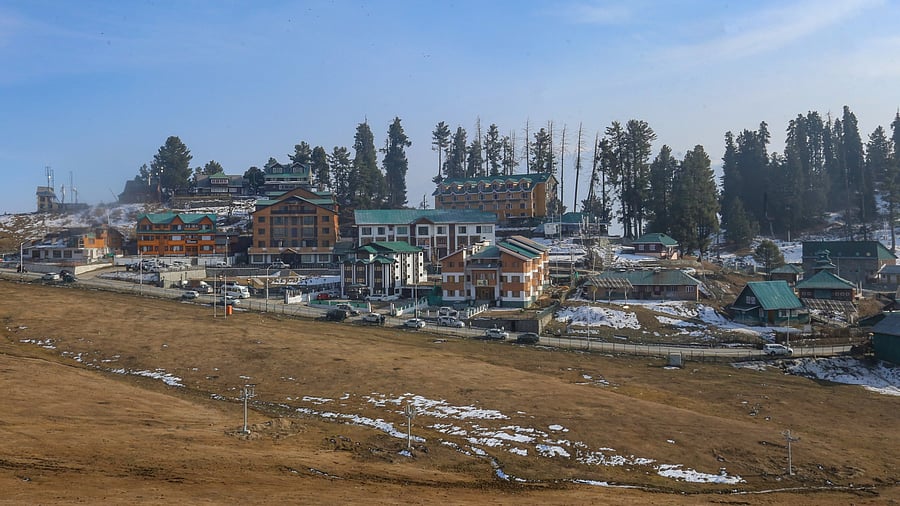
Deserted ski resort at Gulmarg, in Baramulla district, Sunday, Jan. 7, 2024. A large number of tourists, who arrived here on the New Year's Eve in the hope of enjoying skiing and other snow-related activities, had to go back disappointed due to the lack of snowfall.
Credit: PTI Photo
Abdul Majeed Bhat looks at the barren slopes cascading down in front of him and heaves a sigh of despair. He and other ski guides in Gulmarg have been waiting for their clients from around the world to reach the famous hill station in northern Kashmir. But with no sign of snow yet, this winter is turning gloomy for them.
“With violence on the decline in Kashmir, we hoped to see better days. But it seems that nature has now turned against us,” says Bhat, who guides tourists and skiers in Gulmarg to eke out a living for him and his family in nearby Tangmarg. He recalls that a pristine blanket of snow covered the slopes and turned the place into a wonderland by this time every winter till a few years back. For Bhat and hundreds of others like him in Gulmarg, snowfall is not just a weather event, but also a promise of livelihood, which brings with it a chance to showcase their expertise on the slopes and share the joy of skiing with travellers from around the world. “But those days seem to have gone now.”
Not only Gulmarg but Pahalgam, Srinagar and other areas in the valley too have not yet received snowfall this winter. Only areas in the extreme higher reaches recorded minimum snowfall so far.
“A feeble Western Disturbance is expected on January 17 and there may be a light snowfall in extreme higher reaches. However, there is no forecast for snow in the plains and the lower reaches of Kashmir for the next 10 days,” says Mukhtar Ahmad, who heads the India Meteorological Department’s office in Srinagar.
The snowfall patterns have changed in Kashmir over the past few decades, with unpredictability in weather increasing. There is a decline in the snowfall especially during the ‘Chillai Kalan’ – the 40-day harshest spell of winter starting December 21 every year. In recent years, the valley has rather been receiving more snowfall early in November or at the fag end of the winter in February.
Extensive snowfall in the first week of November in 2018 and 2019 damaged apple orchards in Kashmir, signalling changes in the climate.
Dr Irfan Rashid of the Department of Geo-Informatics at the University of Kashmir says that the minimum average temperature in winter has significantly increased and hence water vapours are not precipitating into snow. “That is why we witnessed three snowless Chillai Kalans since 2014 and this year we are staring at the fourth,” he says, adding that prolonged dry weather could adversely affect orchards and fruit crops in Kashmir, posing substantial challenges to agricultural productivity.
The main sources of water for the Jhelum, Chenab and Sindh rivers in the valley are in the Himalayas, where snowfall has been recorded lower than normal this winter so far. The scarce snowfall results in less water in the rivers in the valley, forcing the farmers to give up paddy cultivation.
Rice is the staple food for the people living in Kashmir and it needs irrigation during its growth period starting from June till harvesting in September. The shortage of irrigation facilities during summer is adversely affecting the productivity of the crop, thereby threatening the food security and livelihood of the people dependent upon agriculture and other allied sectors.
“Just after the plantation of paddy saplings, the supply of irrigation water stops, destroying our crops. My large family has so far been dependent on agriculture, but it seems now we may have to look for an alternative source of livelihood,” Bilal Wani, a paddy farmer in northern Baramulla, says.
Sanjeev Malhotra, the chief engineer of the Jal Shakti Department of the Jammu and Kashmir (J&K) government, says that the dry spell has already started impacting the water resources in the union territory. “The surface water sources are not getting recharged in the absence of the snowfall and rainfall, so the precipitation at this juncture is a must to get our sources recharged well in advance for the future months,” he says.
Due to less snowfall and rising temperatures, the Kolahoi glacier that feeds Lidder and Sindh rivulets, both tributaries of Jhelum, has shrunk by almost 23% since 1962. In the past decade, a drought-like situation emerged several times in many parts of Kashmir, forcing authorities to issue advisories to peasants like avoiding growing paddy.
Experts fear that the prevailing trend of depleting snowfall is going to become more frequent in the future.
The fast-vanishing green cover, excessive exploitation of resources, unplanned urbanisation, conversion of agricultural land for commercial purposes and migration of people towards forest areas owing to non-availability of land in cities and towns are being cited as reasons which contribute factors to winters turning warmer.
“All these factors are contributing to change in weather in Kashmir. If the data of the past 30-35 years is taken into account and if we go by different studies, we may end up receiving 30% to 70% less snowfall by the end of this century,” said Prof Shakil Romshoo, the vice-chancellor of the Islamic University of Science and Technology.